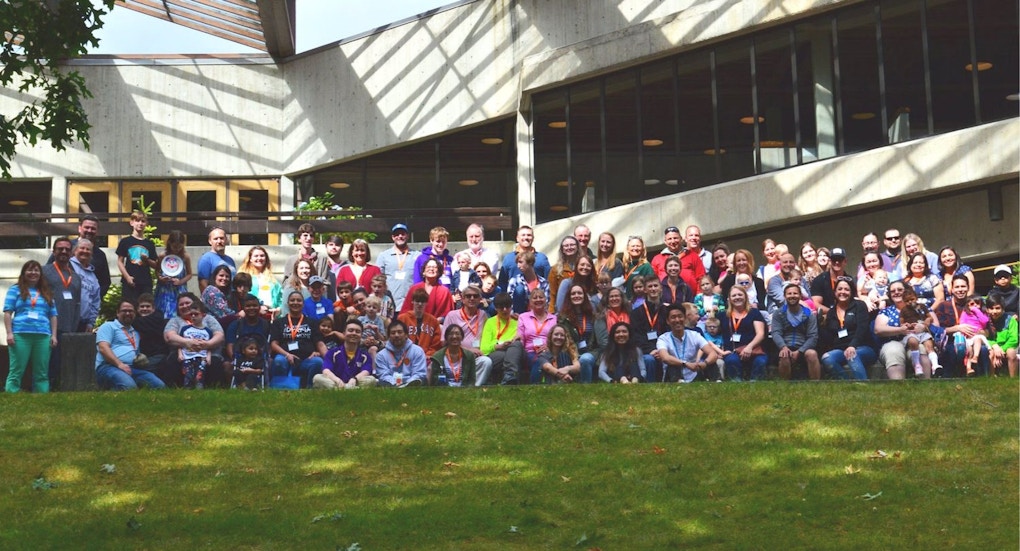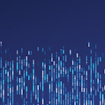
Through a parent’s search for answers and internet connectivity, a DYRK1A Syndrome Family Meetup — the fourth of its kind in the United States — took place in Seattle on June 22, 2019. The meeting provided support for 32 families of people with rare mutations in DYRK1A, a high-confidence autism risk gene, as well as information for scientists trying to grasp the gene’s role in brain development and function.
DYRK1A was first linked to autism through exome-sequencing studies1 of the Simons Simplex Collection (SSC), a project of the Simons Foundation Autism Research Initiative (SFARI) aimed at identifying de novo mutations in families in which only one child is affected by autism. Targeted sequencing of the gene in the SSC turned up more DYRK1A disruptions2.
But DYRK1A mutations are associated with substantially more than autism: intellectual disability, speech delay, motor and feeding difficulties, microcephaly and vision problems beset many carrying these mutations, according to a 2017 study3. In addition, seizures affected 72 percent of that group, and if not an outright autism diagnosis, features of autism-like poor eye contact and repetitive behaviors affected 69 percent.
Some of these difficulties were plain at the meeting, where some children in wheelchairs rolled among families greeting each other. Most wear glasses; some talk, but many do not. The parents shared an information sheet that they could fill out for future teachers or other caregivers in order to orient them to the unique strengths and challenges of their child. Parents heard talks about the latest science of DYRK1A mutations, how to manage problem behaviors and the importance of self-care; siblings also attended a workshop. After the meeting, the families headed back to the hotel for a superhero-themed pajama party.
“These meetings can give families a greater sense of belonging,” says Amy Clugston, meeting organizer and mother of a child with a DYRK1A mutation. “Though this can be done online, it can feel so much more real when people finally meet face to face.”
Collecting the rare
In 2014, Clugston initiated a DYRK1A social media group after finding another parent of a child with a mutation in DYRK1A. Now the group includes over 250 families around the world, and 10 meetings have been organized in the United States and Europe in the past four years.
“At the meetings, families also get to learn and understand more about the syndrome in an upfront and personal way by engaging with the presenters,” she says. “Lastly they get to enjoy fun time with their families and their now extended DYRK1A family.”
The meetings also provide a crash course for scientists to understand the consequences of DYRK1A mutations. Because these are rare events, a clinician may never see a single case over a long career. These meetings also exemplify a “genetics-first” approach to understanding neurodevelopmental disorders, which has been similarly taken by Simons Searchlight,4 a SFARI-supported project, also represented at the meeting. Instead of looking for common genetic changes across a heterogeneous group of people with autism, Simons Searchlight attempts to bring focus by studying people carrying mutations in the same highly penetrant gene.
The meetings may also help identify new leads for research. Researchers came away from the Seattle meeting with more interest in the sleep issues mentioned by families; anecdotally, those with DYRK1A mutations seem to fall asleep well enough but are easily roused. One mother at the meeting shared that her son had never slept well and that a sleep specialist found he only got 15 minutes of REM during six hours of sleep (usually REM comprises 20–25 percent of a night’s sleep). Though sleep issues often afflict people with developmental disabilities, a previous study has linked DYRK1A specifically to clock genes involved in circadian signaling5.
“These family meetings help connect people who have unique insights from life experience of the disorder to scientists who might not be able to pick up on these things using standardized assessments or given their limited opportunities to interact,” says Raphael Bernier, a SFARI Investigator who attended the meeting.
A consequential kinase
Named for the enzyme it encodes (dual specificity tyrosine-phosphorylation-regulated kinase 1A), DYRK1A is better known for its connection to Down syndrome: the gene lies on chromosome 21, which is tripled in that condition. But the families in Seattle were not concerned about too many copies of DYRK1A but too few. Their children carry mutations striking one DYRK1A gene copy that likely disrupt its function.
Normally, the DYRK1A kinase helps keep cellular functions humming by adding phosphates to proteins; anything that disrupts this action likely creates havoc for cell health. People with DYRK1A syndrome carry seemingly damaging mutations, including deletions of part of the gene, mutations that truncate the gene, or missense mutations that introduce a change in the amino acid sequence of the resulting protein3.
Not only does the type of mutation matter, but also its location. According to a 2017 study, DYRK1A missense mutations from participants in the Deciphering Developmental Disorder (DDD) project landed within or close to sites critical for kinase function or in regions important for stabilizing the protein; variations found in seemingly healthy people landed mostly outside of these regions6 (Figure 1). Engineering some missense mutations into DYRK1A proteins confirmed that these snuffed out kinase activity, rendering the protein useless7. This suggests that there are several ways to break the DYRK1A protein; people with different mutations may ultimately have a ‘dead’ kinase in common.

Potential treatments could work to boost DYRK1A activity. The kinase is known to be druggable, thanks to Down syndrome research, which seeks to inhibit the extra kinase activity brought about by the extra copy of DYRK1A. DYRK1A inhibitors tested in clinical trials have reported some cognitive improvements for people with Down syndrome8, but no DYRK1A enhancers have been reported.
Mouse models and brain organoids
Mouse model development can set the stage for testing potential therapies for DYRK1A syndrome. Mice with an inactivated copy of DYRK1A show cognitive impairments, decreased vocalizations, social deficits and seizures9. A recent study on a similar mouse model reported repetitive behaviors, in addition to seizures and social impairments; in the brain, they noted more excitatory neurons than expected, which may be related to seizures10.
Other research has highlighted disruptions to brain development: rat neurons engineered to have too little (or too much) DYRK1A expression exhibited sparse dendritic spines and branches compared to controls (Figure 2). This suggests that DYRK1A helps with managing the conduits needed to carry communication signals between neurons11.

Several parents in Seattle were curious about what happened as these mice aged; for example, links to neurodegenerative diseases have been suggested in cases of DYRK1A overexpression12. There are no clear answers for DYRK1A syndrome now. Currently the age of those identified with DYRK1A mutations skews young, as genetic testing of children with developmental disorders is just beginning to catch on. One way to find older people with DYRK1A mutations may be through SPARK (Simons Powering Autism Research for Knowledge), an initiative sponsored by SFARI to scan the genomes of 50,000 people diagnosed with autism13. Sometimes rare, disabling mutations, such as those reported for DYRK1A, are found. So far, over 200,000 participants have joined SPARK.
Though mice can be made to carry mutations in DYRK1A syndrome, what unfolds in their brains is a coarse approximation of what goes on in human brains because mouse brains are not only smaller but organized differently and composed of somewhat different cell types. Another approach is to develop brain organoids from human cells, specifically from induced pluripotent stem cells (iPSCs) derived from people with DYRK1A syndrome. This may better replicate aspects of brain development in DYRK1A syndrome. For example, early differences in brain cell division and growth may help explain microcephaly, a prominent feature in DYRK1A syndrome that isn’t obvious in mouse models so far. The Simons Searchlight project aims to develop iPSCs from participants, including those with DYRK1A mutations, and to share them with qualified researchers (see list of biospecimens currently available). The project also collects medical and behavioral histories of people with mutations to one of 50 autism-related genes. So far, 39 people with DYRK1A mutations are fully enrolled in Simons Searchlight (Figure 3).

When researchers meet families
On the sidelines of the meeting, DYRK1A research continued. Some families participated in the TIGER (The Investigation of Genetic Exome Research) study at the University of Washington, which seeks to understand the full consequences of rare genetic mutations related to ASD. In all, 11 new families participated in the TIGER study, which doubled the sample size. They sat for interviews and evaluations, blood draws, an optional skin biopsy and electroencephalography (EEG). Not all children can tolerate the full evaluation, but what data they can give is valuable.
Others joined the FaceBase project, which seeks to identify key facial features of people with rare genetic disorders; the project manager set up shop in the hotel where the families were staying in downtown Seattle.
“The importance of family partnerships in this research can’t be oversold,” says Bernier, who headed TIGER until recently.
At family meetings, a two-way process unfolds. “Bringing clinicians, scientists and families together naturally promotes opportunities for scientists to hear about the most salient issues and concerns facing families and clinicians. Then clinicians and families can hear about what scientists are working on and can apply that to their own experiences to take it to the next level,” Bernier says. “The family meeting context allows these things to happen more quickly.”
References:
- O’Roak B.J. et al. Nature 485, 246-250 (2012) PubMed
- O’Roak B.J. et al. Science 338, 1619-1622 (2012) PubMed
- Earl R.K. et al. Mol. Autism 8, 54 (2017) PubMed
- Simons VIP Consortium. Neuron 73, 1063-1067 PubMed
- Kurabayashi N. et al. Mol. Cell Biol. 30, 1757-1768 (2010) PubMed
- Evers J.M. et al. Hum. Mol. Genet. 26, 519-526 (2017) PubMed
- Widowati E.W. et al. Biol. Open 7, bio032862 (2018) PubMed
- Feki A. and Hibaoui Y. Brain Sci. 8, e187 (2018) PubMed
- Raveau M. et al. Neurobiol. Dis. 110, 180-191 (2018) PubMed
- Arranz J. et al. Neurobiol. Dis. 127, 210-222 (2019) PubMed
- Dang T. et al. Mol. Psychiatry 23, 747-758 (2018) PubMed
- Wegiel J. et al. FEBS J. 278, 236-245 (2011) PubMed
- SPARK Consortium. Neuron 97, 488-493 (2018) PubMed


